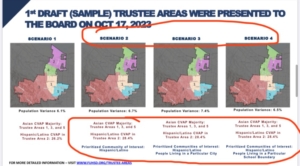Follow up to Allison’s public comment at March 20 map hearing
This is a follow up on my public comment at the Mapping Hearing on March 20. I realize my perspective came as a surprise to many and there is a lot of nuance and complexity that may not have been captured in my 2-minute comment.
First and foremost I want to commend the CTAD committee, staff, and consultant on their incredible thought, care, community outreach, and hours of work put into synthesizing and developing the redistricting maps. It truly is a model of community engagement and transparency. They are well intended people doing important work.
My comment was intended as a critique of our systems of influence, how even when we all do exactly as we are supposed to do and do it well, we still end up leaving the same people behind, over and over again. It seems like small increments, but these increments add up over time, contributing to persistent disparities in representation and opportunities, specifically with historically marginalized and underserved groups like Hispanics/Latinos, especially those from lower income, monolingual Spanish speaking households who may have lower levels of formal education from their countries of origin.
Public input is dominated by those who send advocacy emails, make public comments, and organize community meetings. This will inherently favor the most empowered and most informed in the community. For a myriad of complex and perhaps confounding reasons, families like many of the immigrant Latino families that I know at my kids’ schools and throughout the community don’t use email and are very unlikely to attend board meetings or speak during public comments. Without default regular translation services, they would never be able to be informed or contribute to the process even if they wanted to. Under our current systems of influence, their voice will always be harder to reach and maximize. Their interests and perspectives repeatedly get subsumed by more dominant voices and interests.
CTAD members who presented at the San Miguel PTA meeting did a diligent job. It is also important to consider that this was the first time San Miguel families were presented with this topic and there are inherent challenges in translating complex information via an impromptu translator not familiar with the content. Some of these details are inherently confusing even when presented to highly educated English speakers. I can only imagine how much more confusing it is for immigrant families. Despite admitting they may not have fully understood the process, the consensus of parents via the PTA poll from that meeting was in support of whatever map created the largest Hispanic/Latino percentage.
Based on the demographer’s presentation, the top Sunnyvale portion of maps 2-4 created the most viable, legally compliant map with a prioritized Hispanic/Latino CVAP of 28.4%. Considering that Hispanics/Latinos are a protected minority group under the CVRA, this map scenario should have at least been an option for the board to consider and vote on or would set the bar to meet in subsequent map versions with a Hispanic/Latino CVAP at 28.4%. Instead, the Hispanic/Latino CVAP was combined into the pool of variables to consider and it got compromised with the flood of other advocacy that came into CTAD as the committee synthesized input from other communities of interest. My understanding is that CTAD believes this was prioritized by going to great efforts to come as close as possible with a 27.7% Hispanic/Latino CVAP in maps 5, 6, and 7. However, when I discuss these numbers with Hispanics/Latinos, none of them feel “prioritized” with the close but lower CVAP percentage. They give an eyeroll and a sigh that reflects a sense of not being surprised yet still sad and dismayed. Latino educators responded with “this is what always happens to us, especially in education.” Hispanics/Latinos are a protected group under the CVRA, as well as one of the most historically underrepresented and underserved in the district and should be prioritized above input from other communities of interest. If Hispanics/Latinos are not being prioritized, then they’re not being prioritized.
The area of Sunnyvale north of El Camino Real is a gentrifying community with a wide range of socioeconomic, cultural, and racial diversity. The Venn diagram of mutual interests and challenges of the children of American raised, English speaking, college educated, politically active professionals living in north Sunnyvale will not always align with those of Spanish speaking, Latinx immigrants, many with lower formal educational levels working as house cleaners, construction workers, gardeners, and restaurant workers who also live there. Every kid deserves the opportunity to do well, yet it is these children who persistently get left behind.
In addition, due to Sunnyvale School District’s programs of choice which are designed to integrate students and families across neighborhood lines and build on the strengths in the district’s Title 1 schools, there is more crosstown integration between school communities and neighborhoods than would be captured by specific regional trustee areas.
If there is a challenging lack of consensus over what board representation for north of El Camino should look like, then that is a reflection of this vast diversity. There may be conflicting views in the community of what new trustee areas should look like, but ultimately it matters more where one’s heart is than where their home is.
With respect and best regards,
Allison Joe


Leave a Reply
Want to join the discussion?Feel free to contribute!